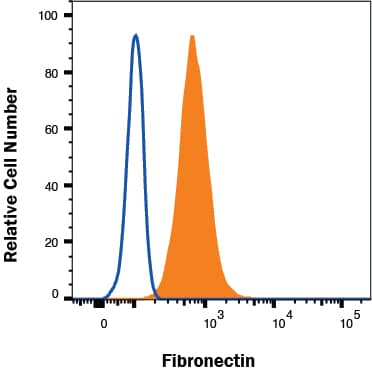Human CD109 Antibody Summary
Val22-Ser1268 (Tyr703Ser & Thr1241Met)
Accession # Q6YHK3
Customers also Viewed
Applications
Please Note: Optimal dilutions should be determined by each laboratory for each application. General Protocols are available in the Technical Information section on our website.
Scientific Data
 View Larger
View Larger
Detection of CD109 in A431 Human Cell Line by Flow Cytometry. A431 human epithelial carcinoma cell line was stained with Mouse Anti-Human CD109 Monoclonal Antibody (Catalog # MAB4385, filled histogram) or isotype control antibody (Catalog # MAB003, open histogram), followed by Phycoerythrin-conjugated Anti-Mouse IgG Secondary Antibody (Catalog # F0102B).
 View Larger
View Larger
CD109 in Human Placenta. CD109 was detected in immersion fixed paraffin-embedded sections of human placenta using Mouse Anti-Human CD109 Monoclonal Antibody (Catalog # MAB4385) at 10 µg/mL overnight at 4 °C. Tissue was stained using the Anti-Mouse HRP-DAB Cell & Tissue Staining Kit (brown; Catalog # CTS002) and counterstained with hematoxylin (blue). Specific staining was localized to cytoplasm in endothelial cells. View our protocol for Chromogenic IHC Staining of Paraffin-embedded Tissue Sections.
Preparation and Storage
- 12 months from date of receipt, -20 to -70 °C as supplied.
- 1 month, 2 to 8 °C under sterile conditions after reconstitution.
- 6 months, -20 to -70 °C under sterile conditions after reconstitution.
Background: CD109
CD109 is a GPI-anchored member of the alpha-2-macroglobulin (A2M) and complement family of proteins (1). Mature human CD109 contains a bait region with recognition sequences for multiple proteases, an internal thioester bond, and a domain similar to the receptor binding domain of A2M (2). Cleavage of A2M family proteins within the bait region activates the thioester bond to promote covalent bonding to nucleophilic groups in adjacent molecules (3, 4). Within the region included in this recombinant protein, human CD109 shares 71-73% amino acid (aa) sequence identity with mouse and rat CD109. It shares 27-33% aa sequence identity with A2M and complement factors C3, C4, and C5. Alternate splicing of human CD109 generates two isoforms with short deletions and one that is truncated within the bait region. CD109 is expressed on activated T cells and platelets, hematopoietic stem cells, megakaryocyte precursors, vascular endothelial cells, basal and myoepithelial cells of secretory glands, and squamous cell carcinomas (2, 5-9). It is produced as a 170-180 kDa glycoprotein that is autocatalytically processed to 150 kDa and 120 kDa forms (2, 6, 10). CD109 on keratinocytes binds TGF-beta and associates with TGF-beta RI and TGF-beta RII, resulting in inhibition of TGF-beta signaling (11). Polymorphisms of CD109 include the platelet-specific Gov antigen and the blood group ABH antigens (12, 13). Alloantibodies directed against these antigens result in unsuccessful platelet transfusions, neonatal alloimmune thrombocytopenia, and posttransfusion purpura (14).
- Travis, J. and G.S. Salvesen (1983) Annu. Rev. Biochem. 52:655.
- Lin, M. et al. (2002) Blood 99:1683.
- Christensen, U. and L. Sottrup-Jensen (1984) Biochemistry 23:6619.
- Wallis, R. et al. (2007) J. Biol. Chem. 282:7844.
- Murray, L.J. et al. (1999) Exp. Hematol. 27:1282.
- Haregewoin, A. et al. (1994) Cell. Immunol. 156:357.
- Hasegawa, M. et al. (2007) Pathol. Int. 57:245.
- Brashem-Stein, C. et al. (1988) J. Immunol. 140:2330.
- Hashimoto, M. et al. (2004) Oncogene 23:3716.
- Solomon, K.R. et al. (2004) Gene 327:171.
- Finnson, K.W. et al. (2006) FASEB J. 20:1525.
- Schuh, A.C. et al. (2002) Blood 99:1692.
- Kelton, J.G. et al. (1998) J. Lab. Clin. Med. 132:142.
- Rozman, P. (2002) Transpl. Immunol. 10:165.
Product Datasheets
Citations for Human CD109 Antibody
R&D Systems personnel manually curate a database that contains references using R&D Systems products. The data collected includes not only links to publications in PubMed, but also provides information about sample types, species, and experimental conditions.
4
Citations: Showing 1 - 4
Filter your results:
Filter by:
-
Converging evidence from exome sequencing and common variants implicates target genes for osteoporosis
Authors: Zhou, S;Sosina, OA;Bovijn, J;Laurent, L;Sharma, V;Akbari, P;Forgetta, V;Jiang, L;Kosmicki, JA;Banerjee, N;Morris, JA;Oerton, E;Jones, M;LeBlanc, MG;Regeneron Genetics Center, ;Idone, V;Overton, JD;Reid, JG;Cantor, M;Abecasis, GR;Goltzman, D;Greenwood, CMT;Langenberg, C;Baras, A;Economides, AN;Ferreira, MAR;Hatsell, S;Ohlsson, C;Richards, JB;Lotta, LA;
Nature genetics
Species: Human
Sample Types: Whole Cells
Applications: ICC -
CD109-GP130 interaction drives glioblastoma stem cell plasticity and chemoresistance through STAT3 activity
Authors: P Filppu, JT Ramanathan, KJ Granberg, E Gucciardo, H Haapasalo, K Lehti, M Nykter, V Le Joncour, P Laakkonen
JCI Insight, 2021-05-10;6(9):.
Species: Human
Sample Types: Whole Cells, Whole Tissue
Applications: IHC, PLA -
High expression of CD109 antigen regulates the phenotype of cancer stem-like cells/cancer-initiating cells in the novel epithelioid sarcoma cell line ESX and is related to poor prognosis of soft tissue sarcoma.
Authors: Emori, Makoto, Tsukahara, Tomohide, Murase, Masaki, Kano, Masanobu, Murata, Kenji, Takahashi, Akari, Kubo, Terufumi, Asanuma, Hiroko, Yasuda, Kazuyo, Kochin, Vitaly, Kaya, Mitsunor, Nagoya, Satoshi, Nishio, Jun, Iwasaki, Hiroshi, Sonoda, Tomoko, Hasegawa, Tadashi, Torigoe, Toshihik, Wada, Takuro, Yamashita, Toshihik, Sato, Noriyuki
PLoS ONE, 2013-12-20;8(12):e84187.
Species: Human
Sample Types: Whole Cells
Applications: Flow Cytometry -
Molecular Signatures of Dengue Virus-Specific IL-10/IFN-gamma Co-producing CD4�T Cells and Their Association with Dengue Disease
Authors: Y Tian, G Seumois, LM De-Oliveir, J Mateus, S Herrera-de, C Kim, D Hinz, NDS Goonawardh, AD de Silva, S Premawansa, G Premawansa, A Wijewickra, A Balmaseda, A Grifoni, P Vijayanand, E Harris, B Peters, A Sette, D Weiskopf
Cell Rep, 2019-12-24;29(13):4482-4495.e4.
FAQs
No product specific FAQs exist for this product, however you may
View all Antibody FAQsReviews for Human CD109 Antibody
There are currently no reviews for this product. Be the first to review Human CD109 Antibody and earn rewards!
Have you used Human CD109 Antibody?
Submit a review and receive an Amazon gift card.
$25/€18/£15/$25CAN/¥75 Yuan/¥2500 Yen for a review with an image
$10/€7/£6/$10 CAD/¥70 Yuan/¥1110 Yen for a review without an image










